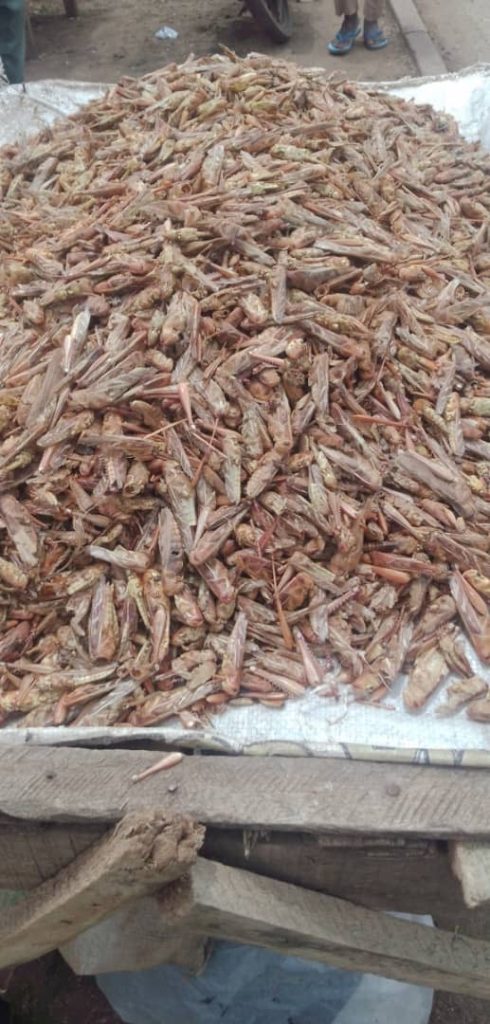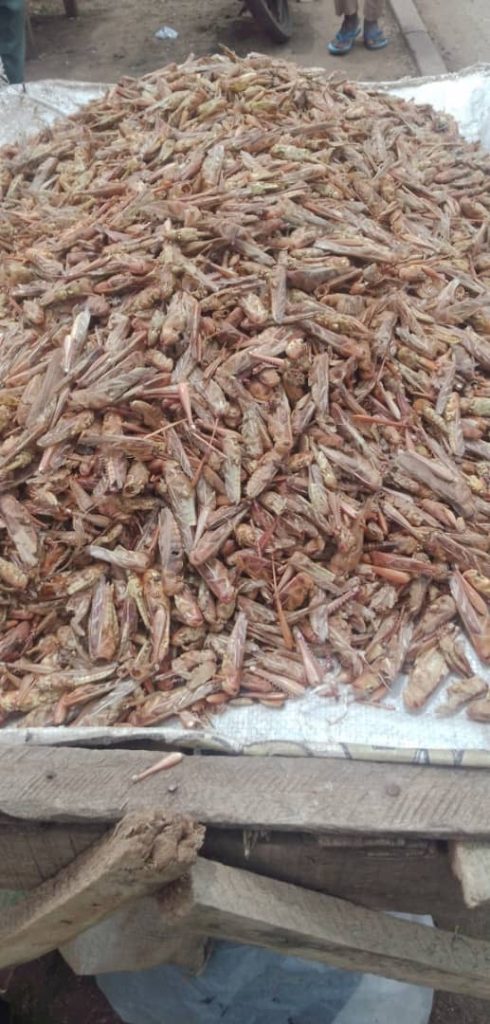Sokoto grasshopper sellers are facing significant hurdles due to seasonal and weather-related factors, impacting both supply and demand.
Findings by ASHENEWS at the central market in Sokoto State revealed that sellers now face difficulties in procuring and selling grasshoppers during certain periods.
Grasshoppers, known for their distinctive ability to jump with long hind legs, thrive in dry habitats such as fields and gardens abundant with grass.
Classified under the Caelifera group, which includes locusts, there are approximately 11,000 species of grasshoppers, predominantly within the Acrididae family.
To distinguish them from similar insects like bush crickets or katydids, grasshoppers are sometimes referred to as “short-horned grasshoppers.”
When certain species undergo behavioural and colour changes due to increased population density, they are termed locusts.
Grasshoppers typically feed on grass, leaves, and cereal crops, with some species being omnivorous and others specialising in specific plant types.
In regions like Sokoto State, species such as Sphenarium grasshoppers are consumed as a source of protein, minerals, and vitamins.

The process of harvesting grasshoppers involves collecting them at dusk using lamps and nets, followed by methods such as soaking, boiling, sun-drying, frying, or seasoning with spices like garlic and chilli.
They are useful in various dishes and soups, reflecting their culinary versatility.
During the harmattan season, there is heightened demand for grasshoppers, traditionally priced at N500 per plate (mudu).
A grasshopper vendor at the central market, Mr Abdul Karen Abubakar, outlined his supply chain, sourcing grasshoppers from Bakin Dutse, Munwadata, and Mallamawa local governments.
Farmers either deliver directly to the market or through intermediaries, depending on logistics and availability.
“I buy my grasshoppers from Bakin Dutse, Munwadata, and Mallamawa local governments. Sometimes, we send money to sellers in the villages, and they bring the grasshoppers to us. Other times, they bring them straight to the market for us to purchase.
“Grasshoppers are in high demand during the harmattan season. Currently, they are scarce and expensive. Normally, we sell one plate (mudu) for N500 during harmattan, but now, due to scarcity, the price has risen to N2500 per plate.”
However, scarcity has driven prices up to N2500 per plate, presenting financial challenges for both sellers and consumers alike.

Another vendor, Mr Yahaya Musa ascribed the inconsistent availability of grasshoppers specifically in the Mullela local government to agricultural factors.
As a result, the abundance during harmattan contrasts starkly with scarcity in dry seasons.
“During the harmattan season, they are plentiful and cheap, but in dry seasons, they’re scarce because farmers don’t have many.
“I always have many customers requesting grasshoppers. If I buy 10 bags, I can sell them all in less than a week because customers buy them quickly every day.
“People in Sokoto enjoy eating grasshoppers because they are nutritious and easy to prepare. Some prefer them over dry fish or meat because they are affordable and can be shared among family members,” he told ASHENEWS.
For Mr Zahadeen Garba, who operates seasonally, the hotter months pose significant obstacles, limiting availability and increasing procurement costs.
As a result of this, he focuses exclusively on harmattan sales when demand peaks and costs stabilize.
“Buying grasshoppers now that the rainy season is starting is very costly. I spend a lot of money to buy them, but customers expect low prices because they’re used to cheaper rates during harmattan.”
“I regularly send money to a farmer in Mallamawa local government to bring grasshoppers to me, usually on Saturdays when they come to sell at the market. Sometimes, they bring them daily, depending on how much we need.”
A farmer from Mallamawa local government, Mr. Faruq Silame highlighted the dual role of grasshoppers as agricultural pests and culinary delicacies.
Despite their potential to damage crops, they are quite popular in northern Nigeria during the harmattan season, thereby fuelling a thriving market.
“Grasshoppers are tropical insects that can harm our farms by eating plants, grass, and crops.
“Despite the damage they can cause to farming, grasshoppers are a tasty delicacy here in northern Nigeria, especially during the harmattan season. The grasshopper business thrives during this time.”
Silame further emphasized the connection between the change in seasons and the availability of the commodity.
“We usually send thousands of bags of grasshoppers to Sokoto State every week when they are plentiful during harmattan.
“However, now that the rainy season has started, we can only send about 20 to 30 bags per week. Some weekends, we don’t send any because we don’t have enough.”
The shift to rainy seasons significantly reduces supply, with only a bit of the harmattan yield being possible for transport to Sokoto markets.
This instability underscores the tough balance between agricultural impact and culinary demand in the region.
While Sokoto grasshoppers are cherished for their nutritional benefits and culinary uses, their seasonal availability and market dynamics present tough challenges for farmers and vendors alike.



